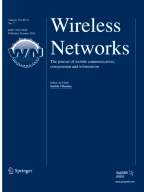Abstract
The dynamic nature of the nodes on the mobile ad hoc network (MANET) imposes security issues in the network and most of the Intrusion detection methods concentrated on the energy dissipation and obtained better results, whereas the trust remained a hectic factor. This paper proposes a trust-aware scheme to detect the intrusion in the MANET. The proposed Trust-aware fuzzy clustering and fuzzy Naive Bayes (trust-aware FuzzyClus-Fuzzy NB) method of detecting the intrusion is found to be effective. The fuzzy clustering concept determines the cluster-head to form the clusters. The proposed BDE-based trust factors along with the direct trust, indirect trust, and the recent trust, hold the information of the nodes and the fuzzy Naive Bayes determine the intrusion in the nodes using the node trust table. The simulation results convey the effectiveness of the proposed method and the proposed method is analyzed based on the metrics, such as delay, energy, detection rate, and throughput. The delay is in minimum at a rate of 0.00434, with low energy dissipation of 9.933, high detection rate of 0.623, and greater throughput of 0.642.
Similar content being viewed by others
References
Kuo, W.-K., & Chu, S.-H. (2016). Energy efficiency optimization for mobile ad hoc networks. IEEE Access, 4, 928–940.
El Khawaga, S. E., Saleh, A. I., & Ali, H. A. (2016). An administrative cluster-based cooperative caching (ACCC) strategy for mobile ad hoc networks. Journal of Network and Computer Applications, 69, 54–76.
Kuppusamy, P., & Kalaavathi, B. (2012). Cluster-based data consistency for cooperative caching over partitionable mobile adhoc network. American Journal of Applied Sciences, 9(8), 1307–1315.
Marchang, N., Datta, R., & Das, S. K. (2017). A novel approach for efficient usage of intrusion detection system in mobile ad hoc networks. IEEE Transactions on Vehicular Technology, 66(2), 1684–1695.
Khamayseh, Y. M., Aljawarneh, S. A., & Asaad, A. E. (2017). Ensuring survivability against black hole attacks in MANETS for preserving energy efficiency. Sustainable Computing: Informatics and Systems, 18, 1–23.
Tseng, C. (2006). Distributed intrusion detection models for mobile ad hoc networks. Ph.D. thesis, University of California Davis.
Umamaheswari, S., & Radhamani, G. (2015). Enhanced ANTSEC framework with cluster-based cooperative caching in mobile ad hoc networks. Journal of Communications and Networks, 17(1), 40–46.
Singh, O., Singh, J., & Singh, R. (2018). Multi-level trust based intelligence intrusion detection system to detect the malicious nodes using elliptic curve cryptography in MANET. Cluster Computing, 21(1), 51–63.
Narayandas, V., Tiruvayipati, S., Hanmandlu, M., & Thimmareddy, L. (2017). Anomaly detection system in a cluster-based MANET. In Proceedings in computer communication, networking and internet security (pp. 11–21). Singapore: Springer.
Feng, D., Jiang, C., Lim, G., Cimini, L. J., Jr., Feng, G., & Li, G. Y. (2013). A survey of energy-efficient wireless communications. IEEE Communications Surveys and Tutorials, 15(1), 167–178.
Usha, G., Rajesh Babu, M., & Saravana Kumar, S. (2017). Dynamic anomaly detection using cross-layer security in MANET. Computers and Electrical Engineering, 59, 231–241.
Arthur, M. P., & Kannan, K. (2016). Cross-layer based multiclass intrusion detection system for secure multicast communication of MANET in military networks. Wireless Networks, 22(3), 1035–1059.
Shams, E. A., & Rizaner, A. (2018). A novel support vector machine based intrusion detection system for mobile ad hoc networks. Wireless Networks, 24(5), 1821–1829.
Kumarasamy, S., Hemalatha, B., & Hashini, P. (2013). Cluster-based cost efficient intrusion detection system for MANET. In Proceedings in arXiv preprint arXiv:1311.1446 (pp. 1–9).
Gerla, M., Kwon, T., & Pei, G. (2000). On demand routing in large ad hoc wireless networks with passive clustering. In Proceedings in IEEE wireless communications and networking conference (WCNC).
Perkins, C. E. (1997). Mobile ad hoc networking terminology. Internet draft, from draft-IETF-manet-term-00.txt.
Johnson, D. B., & Maltz, D. A. (1996). Dynamic source routing in ad hoc wireless networks. Mobile Computing, 353, 153–181.
Ratnasamy, S., Karp, B., Shenker, S., Estrin, D., Govindan, R., Yin, L., et al. (2003). Data-centric storage in sensornets with GHT, a geographic Hash table. Mobile Networks and Applications, 8(4), 427–442.
Jiang, M., Ti, J., & Tay, Y. (1999). Cluster based routing protocol. Internet draft, from draft-IETF-manet-cbrpspec-01.txt.
Banerjee, A., King, C.-T., & Hsiao, H.-C. (2017). On state maintenance in cluster-based mobile ad hoc networks. Ad Hoc Networks, 66, 95–109.
Sivakumar, R., Sinha, P., & Bharghavan, V. (1999). CEDAR: A core-extraction distributed ad hoc routing algorithm. IEEE Journal on Selected Areas in Communications, 17(8), 1454–1465.
Denning, D. E. (1987). An intrusion detection model. IEEE Transactions on Software Engineering, 13(2), 222–232.
Anjum, F., Subhadrabandhu, D., & Sarkar, S. (2003). Signature-based intrusion detection for wireless ad hoc networks. In Proceedings in VTC (Vol. 3, pp. 2152–2156), USA.
Subba, B., Biswas, S., & Karmakar, S. (2016). Intrusion detection in Mobile Ad hoc Networks: Bayesian game formulation. Engineering Science and Technology, an International Journal, 19(2), 782–799.
Li, J., Lewis, H. W. (2016). Fuzzy clustering algorithms—review of the applications. In Proceedings of the IEEE international conference on smart cloud (SmartCloud) (pp. 282–288).
Störr, H. H. P., Xu, Y., & Choi, J. (2002). A compact fuzzy extension of the Naive Bayesian classification algorithm. In Proceedings of InTech/VJFuzzy.
Author information
Authors and Affiliations
Corresponding author
Rights and permissions
About this article
Cite this article
Veeraiah, N., Krishna, B.T. Trust-aware FuzzyClus-Fuzzy NB: intrusion detection scheme based on fuzzy clustering and Bayesian rule. Wireless Netw 25, 4021–4035 (2019). https://doi.org/10.1007/s11276-018-01933-0
Published:
Issue Date:
DOI: https://doi.org/10.1007/s11276-018-01933-0
